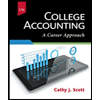
a.
Introduction:
To prepare: The payroll register.
b.
Introduction: Journal entry is the first step of accounting to record day-to-day transactions that a business performs. It helps in further preparing financial statements at the end of the period to assess the financial position of the business.
To prepare: The journal entry.
c.
Introduction: Journal entry is the first step of accounting to record day-to-day transactions that a business performs. It helps in further preparing financial statements at the end of the period to assess the financial position of the business.
To prepare: The journal entry.
d.
Introduction: Journal entry is the first step of accounting to record day-to-day transactions that a business performs. It helps in further preparing financial statements at the end of the period to assess the financial position of the business.
To prepare: The journal entry.
e.
Introduction: Journal entry is the first step of accounting to record day-to-day transactions that a business performs. It helps in further preparing financial statements at the end of the period to assess the financial position of the business.
To prepare: The journal entry.
Want to see the full answer?
Check out a sample textbook solution
Chapter 11 Solutions
BA 511 CUSTOM CONNECT FOR FUND ACC PRINC
- Can you demonstrate the accurate method for solving this financial accounting question?arrow_forwardI am looking for a reliable way to solve this financial accounting problem using accurate principles.arrow_forwardCost of Units Completed and in Process The charges to Work in Process-Assembly Department for a period, together with information concerning production, are as follows. All direct materials are placed in process at the beginning of production. Work in Process-Assembly Department Bal., 7,000 units, 65% completed Direct materials, 165,000 units @ $1.3 21,385 214,500 To Finished Goods, 161,000 units ? Direct labor Factory overhead 333,600 129,675 Bal. ? units, 30% completed a. Based on the above data, determine the different costs listed below. If required, round your interim calculations to two decimal places. 1. Cost of beginning work in process inventory completed this period. 2. Cost of units transferred to finished goods during the period. 3. Cost of ending work in process inventory. 4. Cost per unit of the completed beginning work in process inventory, rounded to the nearest cent. b. Did the production costs change from the preceding period? es X $ $ c. Assuming that the direct…arrow_forward
 Financial And Managerial AccountingAccountingISBN:9781337902663Author:WARREN, Carl S.Publisher:Cengage Learning,
Financial And Managerial AccountingAccountingISBN:9781337902663Author:WARREN, Carl S.Publisher:Cengage Learning, Financial AccountingAccountingISBN:9781337272124Author:Carl Warren, James M. Reeve, Jonathan DuchacPublisher:Cengage Learning
Financial AccountingAccountingISBN:9781337272124Author:Carl Warren, James M. Reeve, Jonathan DuchacPublisher:Cengage Learning Cornerstones of Financial AccountingAccountingISBN:9781337690881Author:Jay Rich, Jeff JonesPublisher:Cengage Learning
Cornerstones of Financial AccountingAccountingISBN:9781337690881Author:Jay Rich, Jeff JonesPublisher:Cengage Learning Excel Applications for Accounting PrinciplesAccountingISBN:9781111581565Author:Gaylord N. SmithPublisher:Cengage Learning
Excel Applications for Accounting PrinciplesAccountingISBN:9781111581565Author:Gaylord N. SmithPublisher:Cengage Learning College Accounting (Book Only): A Career ApproachAccountingISBN:9781337280570Author:Scott, Cathy J.Publisher:South-Western College Pub
College Accounting (Book Only): A Career ApproachAccountingISBN:9781337280570Author:Scott, Cathy J.Publisher:South-Western College Pub College Accounting (Book Only): A Career ApproachAccountingISBN:9781305084087Author:Cathy J. ScottPublisher:Cengage Learning
College Accounting (Book Only): A Career ApproachAccountingISBN:9781305084087Author:Cathy J. ScottPublisher:Cengage Learning





